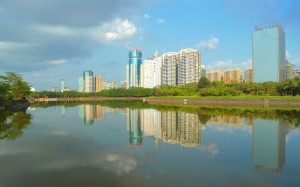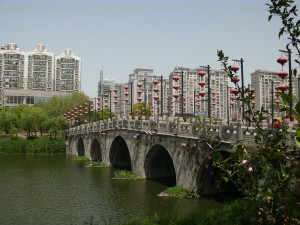Will China’s urbanisation process result in improvements to social welfare and an eventual reform of the hukou system?
Li Tie, Director General of the China Centre for Urban Development (CCUD) says that this exciting part of China’s history will indeed lead to a fairer system for migrant workers, who will eventually be entitled to receive the same social benefits and quality of life as their urban cousins. He believes this is a necessary advance as China transitions to a consumption-based economy.
He also says that cooperation between the European Union (EU) and China in the field of urbanisation through such mechanisms as the EU-China Urbanisation Partnership High Level Conference should lead to significant future collaboration in urbanisation projects between the two states.
 Many people around the world have mixed feelings about urbanisation in China — curiosity, concern as well as a sense of opportunity. The following statistics will help to provide an insight into this issue.
Many people around the world have mixed feelings about urbanisation in China — curiosity, concern as well as a sense of opportunity. The following statistics will help to provide an insight into this issue.
China currently has an urban population of 710 million, but its urbanisation rate is only 52.6 per cent. In the decade before 2012, China’s urbanisation rate grew by an average of 1.4 per cent annually, which means 20 million people were moving from rural to urban areas for jobs every year. While China’s economic growth has slowed due to the Global Financial Crisis and GDP growth has fallen to only seven to eight per cent, urbanisation rates can be kept at 0.8 to one per cent growth, which means that at least 200 million people in China will move to cities over the next 20 years.
China is expected to have an urban population of 900 million by 2030, 400 million of which will be new arrivals from rural areas. Recent reforms implemented by the Chinese Government will ensure that these people will be able to settle into urban areas and gradually enjoy the same public services as urban residents. This means that consumer habits among this group will also become more urban, driving consumer demand and with it the demand for investment.
These individuals need to rent or buy homes in cities and purchase goods. They must also have access to public services such as education and health care. Cities of varying sizes where these individuals live must invest in basic infrastructure to improve living conditions. Transportation must also be improved to facilitate movement between these cities. This demand is real and must serve a massive population.
Today, China has over 20,000 cities and towns of various sizes: five of which have populations over 10 million;  18 with a population of over four million; 127 with a population of over one million; 1,500 with a population of over 50,000; and 20,000 with an average population of around 10,000. These cities and towns will attract hundreds of millions of people in the coming decades and must solve infrastructural problems, improve public services and adjust industrial structures while at the same time guaranteeing low-carbon, green, and ecologically sustainable development.
18 with a population of over four million; 127 with a population of over one million; 1,500 with a population of over 50,000; and 20,000 with an average population of around 10,000. These cities and towns will attract hundreds of millions of people in the coming decades and must solve infrastructural problems, improve public services and adjust industrial structures while at the same time guaranteeing low-carbon, green, and ecologically sustainable development.
These cities and towns are faced a number of dilemmas in choosing a development path. How can they lower the cost of urban development? How can they provide public services for new migrant populations? How can they secure funds to invest in infrastructural improvements? How can they attract more investment? How can they reduce energy and resource consumption?
China must learn from the experiences of cities around the world in the course of its urbanisation efforts to ensure good public services while at the same time driving rapid urbanisation and sustainable development.
It is important that we make the huge market potential and opportunities available to encourage exchange and cooperation that will allow advanced technologies in and produce win-win results for everyone. The Joint Declaration on EU-China Partnership on Urbanisation signed by EU President José Manuel Barroso and then Chinese Vice Premier Li Keqiang in Brussels on 3rd May, 2012, identified fourteen areas for collaboration in urbanisation between the EU and China.
The EU-China Urbanisation Partnership High Level Conference and the EU-China Exhibition on Urban Development will be held in Beijing during the EU-China summit in late-2013. Running from the 20th – 23rd November at the Beijing Exhibition Hall, the EU-China Exhibition on Urban Development, in particular, aims to turn conceptual consensus reached through the EU-China Urbanisation Partnership into practical operation, providing opportunities to promote EU-China collaboration, investment and market expansion between cities and enterprises.
The Exhibition will bring together tens of thousands of Chinese government officials, entrepreneurs and people in a variety of industries, providing a space and platform to exchange and learn about experiences in urban development in both China and the EU as well as market potential, demand, technology and specific projects. We believe that significant collaboration in urban development will result from these numerous exchanges and activities, providing mutually beneficial opportunities for all involved.
The CCUD specialises in policy research on urbanisation and urban development. Entrusted by the National Development and Reform Council (NDRC), it is responsible for providing guidance for 711 pilot cities under the National Development and Reform Pilot Programme. Major functions of the CCUD include providing policy consultancy on urbanisation and urban development; assisting cities in formulating various development plans; and organising international conferences.
Li Tie is currently leading several major research projects, such as China’s Urbanisation Strategy for the Twelfth Five-year Plan, Capacity Building of Governments in Promoting Social Inclusion for Migrant Workers and their Family Members, Urban Planning to Promote Healthy Development, Governance Structure of Governments and Farmers’ Employment in the Process of Urbanisation, Movement of Population in the Process of Urbanisation, and Strategies for and Management of Urbanisation in Rural Areas.
He receives the State Council Special Expert Allowance, a prestigious status for top experts. He is also a senior research fellow at the Tsinghua University and a doctoral advisor at the China Agricultural University. He received his bachelor’s degree in geography from China Northeastern Normal University in 1982 and a master’s degree in history in 1987 from the same university.


I can’t tell if the author genuinely believes encouraging urbanisation and increasing consumption can be married with reducing resource consumption and increasing social wellbeing, or has just thrown these buzzwords in to mark himself as on the same page as ‘everyone else’. Self-evidently you cannot both incentivise and aim to reduce consumption. Similarly, however ‘sustainabily’ you aim to build your cities, they still massively alter water tables, natural habitats, air quality etc… through sheer volume of concrete, emissions, population density etc…
If we look at developments in those already very mature economies the trend is absolutely towards minimising city building, working from home. To utilising the Internet to spread economic development and opportunities evenly across the country rather than concentrating it onto cities and letting the rural atrophy and die – as is already happening to an alarming scale in China.